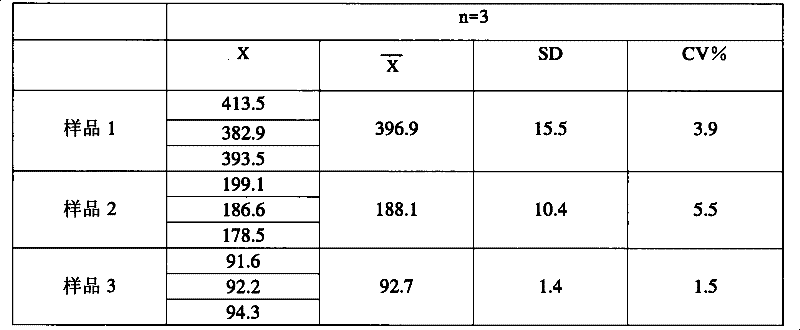Method for preparing polyclonal antibody against mouse nerve growth factor (NGF) and application thereof
A technology of nerve growth factor and polyclonal antibody, which is applied to the preparation method of peptide, anti-growth factor immunoglobulin, chemical instruments and methods, etc.
- Summary
- Abstract
- Description
- Claims
- Application Information
AI Technical Summary
Problems solved by technology
Method used
Image
Examples
Embodiment 1
[0054] Example 1 Preparation of polyclonal antibodies
[0055] prepare
[0056] 1. After the purified NGF is polymerized by glutaraldehyde, at 150μg per animal, it is fully mixed and emulsified with an equal volume of complete Freund's adjuvant, and injected into normal rabbits subcutaneously at multiple points;
[0057] 2. One month later, the same amount of antigen and incomplete Freund's adjuvant were fully mixed and emulsified, and subcutaneously injected again at multiple points;
[0058] 3. After one month, repeat step 2;
[0059] 4. One week after the last immunization, ear blood was collected, and the titer was measured by indirect ELISA, and the titer was greater than 1:1000;
[0060] 5. Blood was collected from the marginal ear vein, 50ml / time, collected twice, serum was collected, and stored at -20°C.
Embodiment 2
[0061] Example 2 Purification of polyclonal antibodies
[0062] 1. Preparation of antigen affinity column: The purified antigen (mouse submandibular gland nerve growth factor NGF) was dialyzed in coupling buffer (0.1mol / L NaHCO) 3 , 0.5mol / LNaCl, pH8.3), pre-cooled 0.5mM ~ 50mM HCl wash CNBr-activated sepharose 4fast flow gel several times, negative pressure ultrafiltration, and replaced in coupling buffer; Mix the colloidal particles with 100% gelatin, and stir overnight at 4°C; wash the incompletely bound antigens with coupling buffer; block the activation sites that are not saturated with antigens by blocking the activation site with the blocking buffer (0.2mol / L glycine) for more than 0.5 hours at room temperature; Buffer and acetate buffer 0.1mol / LCH 3 COO·Na and 0.5mol / L NaCl, pH 4.0) were alternately washed for more than 2 times, and the micelles coupled with antigen were stored in 20% alcohol.
[0063] 2. Binding buffer (PBS) fully equilibrates the antigen-conjugated...
Embodiment 3
[0068] Embodiment 3 ammonia sulfate-n-octanoic acid method purification method:
[0069] Take a certain volume of serum and dilute it by 2 or 4 times with 0.06mol / L HAc-NaAc buffer at pH 4.8; add n-octanoic acid dropwise to make the final concentration 75 μl / ml (n-octanoic acid / rabbit serum), and stir 30min, centrifuge at 12000r / min for 20min at room temperature and take the supernatant; add 0.1mol / L pH7.4 PBS solution with a volume of 1 / 10 of the supernatant, let stand for 2 hours or overnight at 4°C; centrifuge at 12000r / min at 4°C for 30min , discard the supernatant; dissolve the precipitate in a certain volume of 0.01 mol / L pH 7.4 PBS, and dialyze with 50-100 times the volume of 0.01 mol / L pH 7.4 PBS at 4°C overnight.
PUM
 Login to View More
Login to View More Abstract
Description
Claims
Application Information
 Login to View More
Login to View More - R&D
- Intellectual Property
- Life Sciences
- Materials
- Tech Scout
- Unparalleled Data Quality
- Higher Quality Content
- 60% Fewer Hallucinations
Browse by: Latest US Patents, China's latest patents, Technical Efficacy Thesaurus, Application Domain, Technology Topic, Popular Technical Reports.
© 2025 PatSnap. All rights reserved.Legal|Privacy policy|Modern Slavery Act Transparency Statement|Sitemap|About US| Contact US: help@patsnap.com

